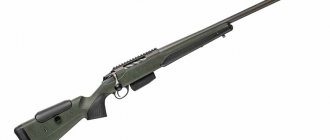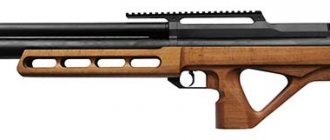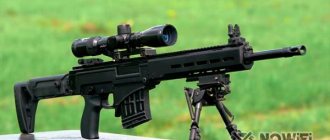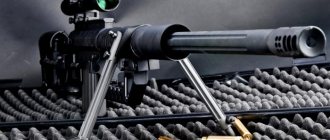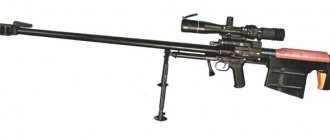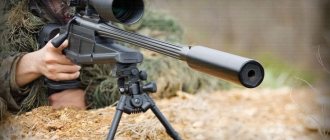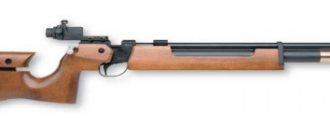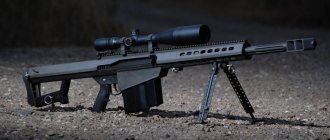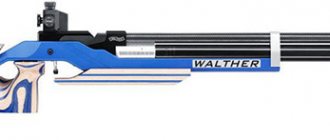History of development
It is customary to start talking about the history of the development of the TOZ-17 from the moment when the famous TOZ-8 was released (1932), which became the ancestor for many small-caliber rifles. Based on this model, the TOZ-16 single-shot carbine was created in 1957, which marked the beginning of the famous line of small rifles.
Small TOZ-16 - single-shot carbine
Just a year after the creation of the first model, engineers at the Tula Arms Plant began developing a five-shot modification of the TOZ-17, which surpassed the prototype in all respects. Subsequently, the manufacturer produced highly specialized models: the expensive TOZ-18, as well as the almost ideal TOZ-17-01.
Commercial single-shot small-caliber
The first commercial carbines of the Tula Arms Plant TOZ-11 and TOZ-16 were high-precision weapons, which was a consequence of their origin from the TOZ-8M sporting rifle.
TOZ-11. View on the right The Tula Arms Factory (TOZ), created by Peter the Great, is the oldest arms enterprise in Russia, world-famous to this day. Of course, it should be noted that in the 90s. In the last century, TOZ experienced hard times, but this can be attributed to the costs of “perestroika.” Things were completely different at the enterprise at the beginning of the 20th century, when the TOZ team initiated the development and production of new types of firearms. This is clearly seen in the example of hunting and sporting rifles chambered for 5.6 mm, which had never been developed or produced in Russia before.
At the beginning of the 20s. A special weapons workshop is being created at TOZ, the main task of which is the development and production of sporting and hunting weapons. Dmitry Mikhailovich Kochetov was appointed its leader in 1922.
The work of the workshop began with the creation of rifles for Soviet athletes. Sporting rifles by Smirnitsky (1925), V.G. are developed and produced here. Selivanov and Ya.I. Kanevsky TOZ-1 (1927) and TOZ-2 (1928), samples by D.M. Kochetova TOZ-7 (1928), TOZ-7A, (1929), TOZ-8 (1932), TOZ-9 (1935), TOZ-10 (1936) and a number of others.
The invaluable experience gained by TOZ specialists during work on small-caliber sporting weapons was used in the post-war period to create hunting rifles chambered for 5.6 mm.
In 1946, designer K.I. Shekhvatov, based on the TOZ-8 rifle, develops the TOZ-11 carbine, which was mass-produced from 1946 to 1957. In 1956 - 1957. The family of small-caliber fishing single-shot carbines was replenished with samples of the lightweight design TOZ-16: TOZ-16-01, TOZ-16-02, TOZ-16-03, TOZ-16-04.
TOZ-11 was developed specifically for commercial hunters who were in great need of such weapons. It differed from the basic TOZ-8M model in its reduced weight and increased survivability during operation, especially in extreme conditions. The change in mass and survivability required the use of new materials and advanced technological processes.
Receiver of the TOZ-11 carbine. The shutter is in the rearmost (open) position
The barrel of the carbine is rifled and connected to the receiver with a press attachment and secured with a pin. The barrel bore is locked by turning the sliding bolt. The firing mechanism is located in the bolt, and the firing pin is cocked when the bolt is moved to the forward position. The trigger mechanism is mounted in the receiver. The cartridge case is extracted and reflected when the bolt is moved to the rear position. The TOZ-11 carbine is equipped with a special safety device against accidental firing when the firing pin is cocked. The safety also prevents the bolt from opening when the trigger is pulled and eliminates the possibility of losing the bolt. The safety clutch is located beyond the edge of the receiver: this technical solution allows, in the event of a misfire, to cock the hammer without opening the bolt. The stock of the weapon is made of walnut wood. The sample sight is open, sector, designed for ranges from 25 to 250 m.
Receiver of the TOZ-11 carbine. Shutter closed
Further improvement of the TOZ-11 design by the plant's gunsmiths led to the creation of a family of hunting small-caliber single-shot carbines of the TOZ-16 series: TOZ-16-01, 02, 03, 04.
Receiver TOZ-16-01. The shutter is in the rearmost (open) position
Any 16-series carbine is characterized by typical design features: the trigger mechanism has a “warning” and a safety device against accidental shooting.
Open sight carbine TOZ-16-01
The cartridge case is removed by an extractor when moving the bolt back and is removed by a reflector outside the receiver. Open sector sight. The semi-pistol stock is made of walnut wood.
Carbine TOZ-16-01. Right view
When firing from a TOZ-16 with a series of 11 shots from a distance of 100 m, ten holes lie in a circle with a diameter of 55 mm, and the distance of the midpoint of impact from the center of the target is 30 mm.
Carbine TOZ-16-01. Left view
TOZ-16-01, 02, 03, 04 have a high degree of unification of parts and assemblies with samples TOZ-8M, TOZ-8-01 and TOZ-11. The total number of parts and assemblies in TOZ-16 is 59, of which eight are borrowed from TOZ-8-01 and 16 from TOZ-8M and TOZ-11. TOZ-11 and TOZ-16 were further developed in a series of more advanced single-shot and repeating carbines of the Tula Arms Plant.
Receiver TOZ-16-01. Shutter closed
Technical characteristics of commercial small-caliber single-shot carbines of the Tula Arms Plant.
| Characteristics | TOZ-11 | TOZ-16-01, TOZ-16-03 | TOZ-16-02, TOZ-16-04 |
| Caliber, mm | 5,6 | 5,6 | 5,6 |
| Cartridge | Rimfire | Rimfire | Rimfire |
| Carbine weight, kg | 2,95 | 2,6 | 3,5 |
| Trigger force, kg | 0,8 — 2,0 | 0,8 — 2,0 | 0,8 — 2,0 |
| Effective firing range, m | 25 — 250 | 100 | 100 |
| Length, mm: - sighting line - weapon - barrel | — 160 1000 500 | — 435 1020 435 | — 535 1125 535 |
| Production period, years | 1946 — 1955 | 1957 | 1957 |
Source : Magazine "Weapons" No. 01 2014
Line of small bore shotguns
The line of small-caliber shotguns includes a variety of models produced by TOZ. Among the popular carbines are the following guns:
- TOZ-16 is the initial version, developed on the basis of TOZ-8. It differs from the prototype in reduced weight, as well as an increased sighting range. This is not to say that a single-shot rifle is bad, but it is noticeably inferior in technical and operational characteristics to further modifications. In addition, the quality of the connection between the receiver and the butt leaves much to be desired, as does the number of rifling in the barrel.
- TOZ-17 is a legendary multi-shot carbine that has many design similarities with TOZ-16, however, all the shortcomings of previous years have been improved in the new version. For example, the number of rifling has increased almost 4 times, which has a better effect on the accuracy of the combat, and the bolt action has acquired a barrel locking mechanism. Most hunters still prefer TOZ-17 from the entire line.
- TOZ-18 is the first modification of the TOZ-17 hunting model, which is distinguished by the presence of a dovetail sighting bar, which allows you to install optics and other “body kit” on the rifle. For shooting, the carbine can use normal or target ammunition. Thanks to this feature, the rifle attracted the attention of not only hunters, but also some units of the Ministry of Internal Affairs and even the KGB of the USSR. For fishing, the model is still a little expensive.
- TOZ-21 is one of the rarest modifications of TOZ-17, which is equipped with a 10-round magazine. In terms of its characteristics, the rifle is almost no different from the combat prototype, but there are some changes in appearance: for example, the stock and butt were made of beech instead of birch, and the barrel was chrome-plated. However, due to the fact that the series was very limited, it is now almost impossible to purchase this model.
Thus, the TOZ-17 rifle still remains the most preferred option for any hunter from the entire small-caliber line.
The founder of domestic sports weapons
During the Civil War, Tula gunsmiths produced two-thirds of the small arms produced in Russia. In 1921, for selfless work in providing the Red Army with weapons, the Tula Arms Plant was awarded the Order of the Red Banner of Labor. In April 1920, the demobilization commission of the Central Board of Artillery Factories sent an order to the First Arms Factory of the RSFSR in Tula to provide a plan for the production of hunting weapons and accessories. The long-awaited time of peace was approaching.
The board of the Tula Arms Factory is creating a hunting workshop of 86 people. The workshop worked on semi-finished hunting rifles left over from pre-war times and turned military rifles into hunting rifles and carbines.
It was in the 20s that the star of the Tula gunsmith Dmitry Mikhailovich Kochetov rose brightly on the arms firmament.
In the 20s of the 20th century after the end of the First World War, gunsmiths around the world were converting military rifles into hunting carbines and shotguns. The weight was lightened as much as possible, the weapon was given hunting ergonomics, and metal and wooden parts were carefully finished. Often high-quality wood was used for the stock, such as walnut or beech. This conversion made it possible to purchase weapons for both poor hunters and to obtain weapons for more demanding shooters.
The USSR was no exception to this general boom of forced conversion. The benefit from providing the national economic market with converted weapons was on the surface and very attractive.
Dmitry Mikhailovich Kochetov
Dmitry Mikhailovich Kochetov was born on July 8, 1897 into a family of hereditary Tula gunsmiths who devoted more than 100 years to the plant.
My father worked at a factory as a mechanic, but died early. His grandfather, Vasily Konstantinovich Bogdanov, took up the task of raising his grandson. Dmitry showed love and interest in gunsmithing from an early age. The grandfather dreamed of raising his grandson to be an educated person, so Mitya enters a real school, which he failed to graduate from. His grandfather, the breadwinner and educator, dies, and the boy goes to work at the factory. But here’s the character: without interruption from production, by the age of 15, he successfully graduated from a weapons school and worked as a mechanic in a lock shop making a three-line rifle of the 1891 model.
By the age of 19, Dmitry Kochetov was developing a device - a device for firing flares using a three-line rifle. This device was patented in 1916 and was actively used by Russian troops at the front.
The aspiring inventor was supported, including by the “grandfather of Russian aviation,” academician, future founder of the Air Force Academy, Professor N. E. Zhukovsky. The young worker's desire to become a designer became stronger.
But the person assumes... Dmitry Kochetov is called up for military service as a weapons technician, and two years later he is demobilized due to injury. Since 1918, Dmitry Mikhailovich again worked at the Tula Arms Factory: first as a mechanic, and then as a turner, technician, senior foreman, assistant to the head of the mechanical workshop, and finally, for his enormous hard work and knowledge of the matter, in 1922 he was appointed head of the hunting workshop of the plant.
The most important stage in Kochetov’s life begins. In 1925 he was appointed design engineer. It was then that the talent of this Tula gunsmith was fully revealed. This is a new bolt cover for the three-line Mosin rifle, which made it possible to protect the bolt from contamination, and therefore from misfire when firing; device for riding in the snow on a motorcycle and bicycle; muffler headphones, which were used in the riveting of blast furnaces at the Novotulsky Metallurgical Plant, in the turbine room of the DneproGES, and by trimmers at the Moscow Automobile Plant; a device for measuring the bores of smoothbore shotguns.
In 1926, at the cooperative hunting exhibition held in Tula, the designer presented a hunting rifle under the symbol “P”. Soon at the Tula Arms Factory this gun was put into mass production and immediately won the recognition of hunters.
Single-barrel hunting shotgun Kochetova model R
The Kochetov model P single-barrel hunting shotgun was mass-produced until 1928. Intended for hunting small and medium-sized animals. Shooting could be done with shot, buckshot and bullets. Barrel 16 gauge cylindrical drilled 712 mm long, chamber 70 mm long for a folder sleeve. The barrels were screwed into a strictly calibrated socket (coupling) with a fine thread, which made it possible to replace a worn-out barrel with a new one, or to replace a barrel of one caliber with a barrel of another. To complete the gun, smooth barrels of 20 and 24 calibers, as well as barrels of 28 and 32 calibers, were also used. The “P” model hunting rifle could also use rifled Winchester barrels of different calibers. When changing barrels, the extractors also changed in caliber. Locking was done with a lever located on the neck of the stock. The trigger mechanism is enclosed in a box with a detachable right wall for ease of debugging. The trigger is internal, but there is a lever on the right side of the box for smooth cocking and lowering. The hammer is also cocked when the barrel is opened. The stock is semi-pistol, connected to the block with one screw on the stock side. Weight 2.8−2.9 kg.
On the basis of the Mosin three-line rifle, in the late 1920s, Dmitry Mikhailovich developed a hunting carbine, ordered by the Mongolian People's Republic, and an 8.2 mm cartridge for it.
Hunting carbine KO-8.2 (NK-8.2)
The KO-8.2 magazine hunting carbine chambered for 8.2×66 mm is designed for hunting large and medium-sized animals in amateur and commercial hunting conditions and is available in two versions with minor design differences.
The KO-8.2 carbine has a barrel, a receiver, a bolt, a trigger mechanism, a mechanism to prevent accidental shots, a single-row box mechanism, a receiver lining, a stock and a cleaning rod.
The carbine's barrel is cylindrical, mounted in the receiver with a threaded connection, and has a front sight base on the muzzle. Receiver with a threaded hole for attaching the barrel, bolt channel and window for loading the carbine, extracting cartridges and for installing a magazine.
The carbine bolt is sliding with the handle turning when the barrel is locked. The firing mechanism is striker-fired, fires without warning and is housed in the receiver. Trigger type safety mechanism. The ejector is plate-type, spring-loaded and is placed in the groove of the bolt cylinder.
The reflector cut-off consists of a plate with a reflective protrusion and a spring part, placed in the groove of the receiver.
The magazine is located under the receiver; the feeding mechanism consists of a feeder, a spring and a strip with a magazine cover.
The sighting device includes a front sight with a front sight and an open sector sight.
Wooden stock of straight shape. The barrel lining is secured with two clamps.
For firing from KO-8.2 carbines, 8.2 mm caliber cartridges with a length of 77.0 - 78 mm with a sleeve length of 66.2 - 66.6 mm and a bullet length of 18.78 - 19.30 mm were used. The mass of the cartridge, bullet, cartridge case and powder charge was, respectively, (in grams) 27.0; 9.5−9.7; 15.52; 1.83.
The bullet is expansive, semi-jacketed: the jacket is made of tombak L-90, the core is made of antimony lead. The sleeve is bottle-shaped, without a rim and made of brass. The capsule is unified with the capsule of the 7.62 mm cartridge for the Mosin rifle mod. 1891/30
The main disadvantage of the KO-8.2 carbines is the rare 8.2 mm caliber cartridge.
At the same time, the designer begins to design samples of sports weapons. By that time it was a courageous act. The fact is that in the Russian, and even more so in the short Soviet history of weapons, the experience in the design and production of sporting weapons was, to put it mildly, insignificant, and what was available did not meet the requirements of the time. It was necessary to create a simple, reliable sporting rifle suitable for mass production. After failures with experimental samples TOZ-2, TOZ-3, TOZ-4, TOZ-5 and a number of other samples, the designer’s efforts were crowned with success. After testing in 1928, Kochetov’s new model, TOZ-7, was accepted for production and in the same year a patent for the rifle was issued. A little later, after eliminating the identified shortcomings (“even the sun has spots”), the TOZ-7A rifle was created
Sports rifle TOZ-7A
A small-caliber single-shot training rifle chambered for 5.6×16 mm rimfire TOZ-7A was developed at the Tula Arms Plant by designer D. M. Kochetov in 1925-1926, put into production in 1928. It was also used as a hunting rifle small caliber rifle. It is a modified system of the German small-caliber rifle Geko. The rifle is made with some simplifications of parts, but is quite durable and reliable, not heavy (3 kg) and has a compact fire. Its distinctive feature was the use of a rotating insert in the receiver. Loading the rifle was greatly simplified: the cartridge was inserted through the window of the receiver and liner and was sent into the chamber by moving the bolt. When the bolt was locked, the liner rotated 90° around its axis and covered the receiver window.
Patent for invention TOZ-7A
Kochetov’s success with the TOZ-7A makes him a well-known designer of sporting weapons in arms circles, and therefore it is no coincidence that he was offered to work on modifying the Smirnsky-2 sporting rifle, which was manufactured in Izhevsk. The sample had a number of shortcomings (misfires, gas breakthrough, etc.), the designer had to eliminate them. Simultaneously with D. M. Kochetov, the designer of the Izhevsk plant, Derzhavin, was working on the modification of the Smirnsky-2 rifle. A specially created commission had to compare the rifles corrected by Kochetov and Derzhavin and approve the best model. The choice fell on the Kochetov rifle model, which was soon accepted for production in Izhevsk.
At the turn of the 30s, Soviet shooting athletes needed a rifle of a more advanced design.
In February 1930, fulfilling the task of the RUZH trust, Dmitry Mikhailovich Kochetov began creating such a rifle. Many years later, the designer recalled: “The rifle was not created in drawings, but directly in a working working model. The plant was producing TOZ-7A at that time, and I took it as a basis, and the innovations were supposed to eliminate the shortcomings.”
In 1931, the rifle was presented for state tests held in Moscow. This is a kind of test of creative maturity, which the Tula designer passed with honor. Along with the rifle of D. M. Kochetov, samples of small-caliber rifles from famous designers A. A. Smirnsky and S. A. Korovin were tested. To organize and conduct tests, the Arms Association appointed a special commission inviting representatives from the headquarters of the Red Army, the Tula Arms Plant, the testing station, and the Dynamo sports society. It was supposed to take two rifles of each system, in parallel with which the Winchester rifle model 52 was to be tested for combat accuracy. When determining superiority, attention was paid to combat accuracy, usability, and originality of the system. D. M. Kochetov’s rifle turned out to be the best and, having received the name TOZ-8, was accepted for production in Tula in 1932.
Sporting rifle TOZ-8
The TOZ-8 single-shot small-caliber rifle is a training-type rifle chambered for a 5.6×16 mm rimfire cartridge. Designed for initial training of athletes, but over a long period of time they were successfully used by commercial hunters (TOZ-8M) due to its accurate combat, simplicity of design and reliability. TOZ-8. A single-shot sports rifle designed by D. M. Kochetov with a striker-type trigger mechanism chambered for a 5.6×16 mm rimfire cartridge with a lead bullet weighing 2.6 g. The cylindrical barrel, 600-640 mm long, is even thicker and heavier, than previous samples. The receiver is closed on the rear side with a lid, the front sight is cylindrical with an elongated base. The bolt is longitudinally sliding and is locked by turning its stem. The front part of the bolt has a reduced diameter with a mounted coupling that rotates when the bolt is turned. There is no fuse. The birch stock has a thickened wide fore-end and a pistol-shaped neck. Weight 3−4 kg.
With the advent of the TOZ-8 rifle, shooting sports began to become increasingly widespread in the organizations of OSOAVIAKHIM, and then DOSAAF. On the solid basis of mass popularity, the skill of Soviet riflemen increased immeasurably. Immediately after the appearance of this rifle, the oldest master from Leningrad, D. P. Ivanov, scored 96 points out of 100 possible in shooting at 500 meters, and Muscovite E. P. Sentyurina scored 196 points out of 200 in shooting from a kneeling position. Subsequently, such high results Many other masters have also shown it.
Continuing to improve the TOZ-8 rifle, the designer uses it to create a new model - TOZ-9.
TOZ-9 repeating sporting rifle
The five-shot small-caliber TOZ-9 repeating rifle, created by D. M. Kochetov on the basis of the TOZ-8 rifle, belongs to the type of sporting weapon. However, its release in 1935 was dictated rather by the requests of commercial hunters. In terms of its design, this rifle is close to the TOZ-8 rifle and differs from the latter in the presence of a magazine. The stock is semi-pistol, the same as that of the previous model rifle. The total weight of the rifle without an optical sight is 3.12−3.25 kg. Barrel length 640 mm. The length of the aiming line is 587 mm (with the sight open).
In 1936, D. M. Kochetov was tasked with developing a target sporting rifle that would be on par with the best world models. Moreover, important international meetings with the strongest shooters in the world were coming up, and it was necessary to provide our masters with first-class domestic weapons.
Our athletes could not shoot from foreign weapons.
Dmitry Mikhailovich recalled: “I was urgently called back from vacation, a whole group of craftsmen was allocated, led by an excellent mechanic Ivan Kuzmich Alipov... For five months we almost did not leave the plant. This is how a sample of the TOZ-10 target rifle appeared.”
Single-shot small-caliber sporting rifle TOZ-10
An arbitrary single-shot small-caliber sporting rifle TOZ-0 of 5.6 mm caliber chambered for a rimfire cartridge for shooting at a distance of up to 100 m. Developed by D. M. Kochetov in 1936-1938. The design resembles the TOZ-8, but differs from it in changes in the design of the stock and the method of attaching the barrel to the receiver. The receiver, locking, trigger and impact mechanisms have been improved.
The barrel is 737 mm long with six pareses and a rifling pitch of 400 mm, with a longitudinally sliding rotary bolt and a trigger force (adjustable) of 50 g. The sight is dioptric, designed by Solovyov, but it is possible to install a diopter sight of another type. The length of the aiming line is 820 mm. The front sight is of a replaceable type, fixed in a tubular, cylindrical front sight. The birch stock is semi-pistol-shaped. The total length of the rifle is 1180 mm, weight 5.4 kg. The initial bullet speed is 315 m/s. The weight and balance of the rifle could be changed through a system of additional weights.
The rifle had high combat accuracy. When shooting from it, such exceptional results as 400 points out of 400 possible at a distance of 50 m on target No. 7 were repeatedly achieved. However, the sample required some improvement in relation to the trigger mechanism and ensuring greater stability of the battle.
In five months we managed to create an excellent rifle. When creating it for craftsmen, the designer followed a completely special path. He radically changed the barrel, paying special attention to the quality of the barrel bore, made an original mount for the barrel with the receiver at two points and thereby created an emphasis on the receiver, and left the barrel completely free. This method went against all the traditions rooted in our and foreign practice, but it turned out to be extremely valuable. This can be seen from the fact that at the end of 1937 (Kochetov’s rifles were manufactured at the beginning of 1937), the Americans, while modernizing the Winchester rifle, also switched to attaching the receiver to the stock, leaving the barrel free.
The Tula inventor was ahead of American designers.
D. M. Kochetov not only designed this rifle, but also developed the entire technological process of its manufacture and performed all the important work with his own hands.
The rifle has passed the most stringent tests. It gave unprecedented results at that time in terms of combat accuracy, as shooters say, “well” (the zeros form a solid hole in the target).
In 1937, Soviet shooters emerged victorious at international competitions, scoring 1,984 points out of a possible 2,000. With this they wrote a glorious page in the history of Soviet shooting sports. The remarkable qualities of the rifle created by the Tula gunsmith were confirmed.
Inspired by such successes, Dmitry Mikhailovich makes plans for the future and works with even greater dedication. But everything was destroyed by the outbreak of the Great Patriotic War.
In the fall of 1941, as the front line approached Tula, Dmitry Mikhailovich, like many other career gunsmiths, was evacuated to Izhevsk. But even in evacuation, the designer continues his inventive activities. Now the designer works for the defense industry. He devotes all his strength, skill, all his talent and experience to the development of various devices so necessary for the defense industry. Of particular note is the creation of a bracket for a three-line rifle for a PU sight and an artillery-optical device “Tochka”, designed to check the straightness of the bore of a 7.62-mm rifle of the 1891/1930 model. The introduction of the device had an economic effect in 1942 -1943. in the amount of 881,200 rubles.
In November 1944, D. M. Kochetov returned to the Tula Arms Plant and began designing hunting and sporting weapons, which became the main products of the enterprise in the post-war period.
While engaged in design activities, Dmitry Mikhailovich sought to pass on his knowledge and experience to young people.
By decision of the USSR Government in 1945, a school of weapons craftsmanship was created at the Tula Arms Plant. One of its leading organizers was Dmitry Mikhailovich. This unique school united creative and talented people. The first graduation of 38 gunsmiths took place on January 24, 1948.
Designer D. M. Kochetov in different years of his life.
The great merit of D. M. Kochetov is that he developed a whole range of sporting rifles necessary for the young Soviet shooting sport. The most remarkable of them is TOZ-8, which has not lost its significance even today. More than 80 years have passed since the creation of the rifle, but it still continues to attract the attention of designers who use some of the design features of the TOZ-8 in their work. In the 50-80s, numerous samples of hunting and sporting weapons were created on its basis.
TOZ-8 was readily purchased abroad both for training novice athletes and as a small-caliber hunting rifle.
Taking into account the needs of commercial hunting, Tula gunsmiths created a carbine taking into account the data obtained during the operation of the TOZ-8 rifle. A group of designers at the Tula Arms Plant has developed a commercial single-shot carbine TOZ-16 of lightweight design. Then, on the basis of the TOZ-16, the TOZ-17 fishing carbine with a magazine for five rounds and the TOZ-18, repeating the previous model, but equipped with an optical sight on a removable bracket, were developed. Carbines were produced by the Tula Arms Plant in 1950-70.
For his activities, D. M. Kochetov was awarded the honorary titles “Best Inventor of the USSR”, “Honored Veteran of Labor TOZ”, “Honorary Member of DOSAAF”. He was awarded the Order of the Red Star, the Red Banner of Labor, and medals “For Valiant Labor in the Great Patriotic War of 1941–1945” and “For Labor Distinction.”
Dmitry Mikhailovich died in 1978. Buried in Tula.
Features of the carbine
Many hunters who decide to purchase a TOZ-17 carbine are primarily concerned with the question of how exactly it differs from the previous TOZ-16 model. Here is a list of the main features of the small thing, in comparison with its progenitor:
- Availability of a magazine for 5 rounds. Reloading is carried out using a longitudinal sliding bolt, and the used cartridge case is ejected under the action of an extractor.
- More rifling inside the barrel channel. It has the best effect on the accuracy of combat, especially when using cartridges from long distances.
- Increased shot power. Now the rifle can be used to hunt large fur-bearing animals and birds.
- The presence of a birch bed. It has a more ergonomic, anatomical shape, which has a better effect on the ease of use of the gun.
- The presence of a shutter locking mechanism. It consists of grooves and recesses - nothing extraordinary, but it works properly.
The new model began to have a much lower percentage of defects than the TOZ-16 rifle. From now on, owners will no longer have to independently modify the trigger or the muzzle with a file in order to get rid of burrs.
Handyman
|
|
|
TOZ-7A.
In 1929, the Tula Arms Plant produced a small-caliber rifle called model 7A. It differs from the previous sample in the following changes: 1) the outside of the barrel is not conical, but cylindrical and heavier in weight; 2) the pitch of the rifling is reduced from 480 to 350 mm; 3) pistol-shaped stock neck and thickened fore-end; 4) the rifle is heavier than the previous model rifle and 5) the bolt has a reduced diameter and is placed in a cylindrical sleeve, which speeds up loading. The sight is the same as on the previous rifle. Disassembly and assembly. Disassembly is carried out only when inspecting, cleaning and lubricating the rifle. Excessively frequent disassembly causes minor malfunctions (beaten™, bruises, etc.) and is harmful, as it accelerates wear of the mechanisms. Disassembly and reassembly of the bolt is carried out only in cases of severe contamination, sand penetration into the stock, etc. Disassemble the rifle in the following order: a) with the index finger of your left hand, press the trigger all the way back, and remove the bolt with your right hand; b) disassemble the bolt, for which, using a drift, push out the trigger pin and separate it from the trigger; Use a screwdriver to unscrew the bolt nut, remove the firing pin with the mainspring and separate the spring from the firing pin; c) push out the ejector pin, separate it, remove the spring; d) use a drift (2 mm) to push out the heel of the striker from the side of the ejector groove and carefully separate it, remove the rebound spring and the rebound; e) separate the barrel and set it aside, for which: 1) unscrew the barrel stop screw, 2) unscrew the receiver tail screw, 3) insert your index finger into the receiver and, lifting it up, separate the barrel; f) separate the trigger mechanism and disassemble it, for which: 1) unscrew the screws of the trigger spring and separate the trigger mechanism from the receiver, 2) push out the trigger pin and 3) separate the spring from the hook; g) separate the liner, for which, placing the barrel with the bottom side up, unscrew the stop and remove the liner; h) disassemble the stop by removing the stop and separating the stop spring. The rifle is assembled in the reverse order.
TOZ-8
TOZ-8 and TOZ-9
Small-caliber training rifles chambered for 5.6×16 mm rimfire cartridge. Old sports models 1932-1946. Designed for initial training of athletes, but over a long period of time they were successfully used by commercial hunters (TOZ-8M) due to accurate combat, simplicity of design and reliability. Models TOZ-8 and TOZ-9 can be considered to a certain extent unified models and; their difference is that TOZ-9 has a magazine, and TOZ-8 is a single-shot rifle. In TOZ-9 the handguard has been changed. Otherwise, the design of both models is similar. TOZ-8. A single-shot sports rifle designed by D.M. Kochetov with a striker-type trigger mechanism chambered for a 5.6×16 mm rimfire cartridge with a lead bullet weighing 2.6 g. The cylindrical barrel, 600-640 mm long, is even thicker and heavier, than previous samples. The receiver is closed on the rear side with a lid, the front sight is cylindrical with an elongated base. The bolt is longitudinally sliding and is locked by turning its stem. The front part of the bolt has a reduced diameter with a mounted coupling that rotates when the bolt is turned. There is no fuse. The birch stock has a thickened wide fore-end and a pistol-shaped neck. Weight 3-4 kg.
TOZ-8M.
In 1934, the Tula Arms Plant produced a small-caliber rifle, model 8A. The caliber, cartridge and barrel are the same as for the previous sample. This rifle compares favorably with the TOZ-8 due to its more advanced sector-type sight, which allows for quick and accurate height adjustment. The front sight is equipped with a ring ear muff. The valve is small in diameter and without a coupling; it is more advanced than the rifle bolt of the previous model, because it does not allow gases to blow back, but it is also convenient when loading. The stock has a significantly thickened fore-end. The rifle is heavier than the previous model. Device. The TOZ-8 small-caliber rifle consists of a barrel, sight and front sight, receiver, bolt, insert, trigger mechanism, receiver cap and stock. The barrel is 640 mm long, has four helical rifling from left to right up, each of which makes about two turns. The length of the rifling stroke is 35 cm. On the barrel, in front of the sighting block, there is a factory mark, the rifle number and the year of its manufacture. Externally, on the muzzle of the barrel, in a longitudinal groove, the base of the front sight is reinforced, on which the front sight with a ring beacon is placed. On the back of the barrel there are two longitudinal grooves into which the projections of the aiming block fit. The rear end of the barrel has a stump to which the front part of the receiver is attached. For a more durable connection, it is fastened to the trunk stump with a special pin. There are two sockets on the edge of the stump: the right one is for placing the ejector head and the left one is for placing the cartridge holder head. The bottom of the stump has a cutout to accommodate the protrusion of the liner. At the bottom of the front part of the receiver there is a transverse groove in which the stop is fixed, into the threaded socket of which the stop screw is screwed, fastening the barrel to the stock. For rifles manufactured 1950-1953. the stop was not made, and the socket for the stop screw was made from below, on the front of the receiver. The receiver serves to house the bolt and insert. A trigger mechanism is also attached to it.
Tip: The recess at the front end of the barrel protects the muzzle of the channel from mechanical damage.
The site has:
Selection and purchase of a hunting rifle Self-loading shotguns of the Bekas-M-auto series Hunting shotgun Mossberg 930 Hunting shotgun MP-27M (IZH-27M) Double-barreled trigger shotgun MP-43KH Self-loading hunting carbine "Vepr" Single-barreled rifled shotgun MP-18MN Hunting carbine Los-7 -1 Hunting carbine Bars 4-1 Remington 750 Woodsmaster. Hunting carbine CZ 550 Single-barrel repeating self-loading rifles and carbines of calibers 7.62 mm and 9.0 mm Vepr, Vepr -308 Single-barrel repeating rifles and carbines of calibers 7.62,8.2 and 9.0 mm, reloadable by hand KO-8 , KO-9, KO-39
Specifications
The technical characteristics of the TOZ-17 weapon have also undergone some changes compared to the previous version. Here is a table taken from the weapons passport, which shows all the main parameters:
| Characteristic: | Parameter: |
| Caliber | 5.6 mm |
| Cartridge | .22LR or .22WMR |
| Barrel length | 536 mm |
| Bullet speed | 350 m/s |
| Sighting range | up to 150 meters |
| Weight | 2.7 kg |
Small hunting rifle TOZ-17 with a case
Despite the fact that the TOZ-17 carbine has received some improvements in terms of performance characteristics, it still belongs to the category of small-caliber weapons, and therefore can be used for hunting only small animals and birds: pheasants, wood grouse, black grouse, hares, foxes, badgers and so on.
Carbine Toz 109. TOZ-122 - the best Tula carbine of serious caliber
The TOZ-122 hunting carbine is a long-awaited development of the Tula Arms Plant, which was demonstrated in 2002. This carbine was developed on the basis of the TOZ-109, and immediately became popular, since fans of Tula carbines had long been waiting for the appearance of a reliable and modern rifled weapon suitable for hunting large animals. In TOZ-122, hunters received a weapon with an attractive design, high reliability and a more than affordable price.
The technical characteristics of this hunting rifle are so good that most reviews from owners of this weapon are positive. Hunters note the high accuracy of the carbine, its reliability and ergonomics.
The history of the appearance of the TOZ-122 carbine
Currently, the TOZ-122 hunting carbine is called the best rifled weapon that the Tula Arms Factory has ever produced. Such statements are based on real reviews from hunters who, comparing their TOZ-122 carbines with other brands of rifled weapons of a similar class, came to the conclusion that it has no competitors in its price category.
Until 2000, the Tula Arms Plant mainly produced carbines of 5.6 mm caliber. The features of these carbines made it possible to hunt with them only small and medium game. For all their many advantages, small-caliber Tula carbines were completely unsuitable for hunting large animals.
By the beginning of 2000, Tula designers decided to develop a new model of a hunting carbine in .308 Win caliber. Already in 2002, the new TOZ-122 carbine was presented to the public, which was intended for hunting medium and large game. The 7.63x51 caliber was enough not only to hunt wild boar or elk, but even bear.
The manufacturer managed to please Russian hunters. Having absorbed all the best qualities of small-caliber carbines and received a serious caliber, TOZ-122 took one of the leading places in its class.
Purpose of the TOZ-122 carbine
The TOZ-122 hunting carbine turned out to be a very balanced weapon. It is perfect for both professional and amateur hunting. The only caveat is that it is not recommended for a beginner to start with such a serious weapon; in extreme cases, you need to study all the nuances and structure of the carbine before going to the shooting range, much less hunting.
In addition to hunting, the carbine can be used for recreational and sport shooting:
- For target shooting;
- For simple accuracy training on various targets;
- For sport shooting competitions.
Some claim that the TOZ-122 carbine can be used for self-defense, but it is definitely not worth arguing that a rifled weapon is the best option for self-defense.
As for the execution, the following wood is usually used for the stocks of this carbine:
Walnut modifications are the most expensive. Also, the carbine can be ordinary, piece or gift. In addition, there are the following modifications:
- TOZ-122M, which is better known as TOZ-122-11. This is a modified version of the standard Tula carbine;
- TOZ-122R - almost identical to the base model. The only difference is the presence of a rubber butt pad;
- Few people know, but there is a carbine in 9.3x62 mm caliber. A very rare modification.
The latest modification is unlikely to be useful in Russian latitudes, because with it you can even hunt an elephant.
Description of design and principle of operation
The carbine was created on the basis of the simple and reliable TOZ-109. The hunting rifle consists of the following parts:
- trunk;
- Receiver;
- Feeding mechanism;
- Trigger;
- Impact mechanism;
- Lodges;
- Store;
- Sighting devices.
Modification TOZ-17-01
One of the best modifications of the TOZ-17 at the moment is the TOZ 17-01 model, produced by the Tula Arms Plant in 1977. The main purpose of the upgrade is to improve existing systems and components, as well as eliminate defects. Here is a list of the main design changes:
- Increasing the length of the barrel by installing an additional narrowing. This did not affect the power of the weapon in any way, but significantly increased its accuracy.
- Applying chrome plating to the inside of the barrel to increase its strength. The outside of the metal was treated with nickel, which has increased rust resistance.
- The receiver acquired a dovetail sighting bar (11 millimeters), thanks to which the owner was able to install optics, a collimator and other “body kit” on the weapon.
- The bolt carrier has been slightly redesigned. Now feeding a cartridge from the magazine was noticeably easier, and the extractor began to work more efficiently.
- The standard push-button safety has been replaced with a flag-type analogue, which is considered much more reliable.
Thus, TOZ-17-01 embodies everything that hunters lacked in TOZ-17. And considering that 20 years passed between the release of these rifles, the engineers really managed to add what the owners dreamed of.
Rifle TOZ-11
Content
TOZ-11. Right view
The TOZ-11 rifle began to be produced in the mid-20th century by the Tula Arms Factory, the oldest enterprise in Russia, which was founded during the time of Peter the Great. This fishing rifle traces its origins back to the TOZ-8M sporting rifle.
History of the creation of the TOZ-11 carbine
In the 1920s, a design bureau was founded at the Tula Arms Plant, which was supposed to design and produce weapons that could be used by athletes and hunters. It should be noted that weapons of this type had not been produced in Russia before. The design bureau was headed in those years by Dmitry Mikhailovich Kochetov.
The first copies created by the new team were the TOZ 1 and TOZ 2 sporting rifles; they were released in 1927 and 1928, respectively. When developing sporting weapons, the designer's staff acquired the experience that was required when working on small-caliber rifles for hunting chambered for a 5.6 mm caliber cartridge.
As mentioned above, TOZ-11 was developed on the basis of the TOZ-8M rifle in 1946 by designer K.I. Shekhvatov, and was in mass production until 1957. The TOZ-11 carbine was intended for commercial hunters, who then needed such a weapon.
The TOZ-8 model, which served as the base, was heavier and had a much shorter lifespan than the small TOZ-11, especially in difficult operating conditions. The designers were able to lighten the model and increase its service life thanks to the advent of new materials, plus more advanced technological processes were developed.
Subsequently, the TOZ-11 small-caliber rifle served as the basis for the creation of a series of TOZ-16 carbines.
Characteristics of the carbine
Receiver of the TOZ-11 carbine.
The bolt is closed. Small-caliber single-shot rifles TOZ-11 are designed for a 5.6 mm (.22LR) rimfire cartridge. A lead bullet weighing 2.6 grams is perfect for hunting small birds and fur-bearing animals. TOZ-11 weighs about 2.95 kilograms. The force required to activate the trigger ranges from 0.8 to 2.0 kilograms. Aimed shooting can be carried out at a distance from 25 meters to 250 meters thanks to the sector sight. The barrel length is 536 mm, the rifle itself is 1020 mm long.
Open sight carbine TOZ-16-01
The rifled barrel of the rifle is connected to the receiver by means of a press attachment and subsequent fixation with a pin. The barrel bore is locked when the sliding bolt is turned. The bolt has a hammer mechanism; the firing pin is cocked when the bolt is locked in the forward position. The trigger mechanism is placed in the receiver. After firing, the cartridge case is ejected when the bolt is pulled back and locked in the rear position.
The trigger is placed on the sear during cocking, pressed by the mainspring, and the cartridge is sent into the chamber. An accidental shot is excluded, even if the firing pin is cocked, a special safety device is provided for this. Thanks to this safety, if the trigger is pulled, the bolt does not open and it is impossible to lose it.
Receiver of the TOZ-11 carbine. The shutter is in the rearmost (open) position
Where and how to buy
Since this weapon has been discontinued, today the TOZ-11 carbine can be purchased either through consignment stores or from private owners. Currently, purchasing a TOZ-11 carbine is not so easy, since it belongs to the rare category. The condition of many is not very good; sometimes repairs or even complete replacement of some parts are required. Information about buying and selling a carbine is published mainly on gun enthusiast forums and message boards. For TOZ-11, the price can vary from 10,000 rubles to 25,000, but it can be higher if the stock is made of valuable wood species. In general, the cost of this series of weapons is lower than that of small-caliber rifles from other manufacturers.
Important! The TOZ-11 carbine is a rifled weapon, and its acquisition requires appropriate permission from law enforcement agencies, despite the fact that the carbine is small-caliber.
Reviews
Reviews for TOZ-11 are not often received, since the item is quite rare and was produced for a limited period of time. Happy owners rate the rifle as reliable, with good accuracy. If you use cartridges with a higher velocity, this figure is lower. When shooting from a distance of about 50 meters with conventional cartridges, the spread of hits is small. The carbine is easy to use, but disassembling the bolt is quite difficult. A cleaning rod is required for cleaning.
What ammo to use
Considering that the rifle can use .22LR and .22WMR cartridges, each of which is divided into several subtypes, choosing the right ballistic projectile can be not so easy. However, professional hunters recommend following the following rules:
- Caliber. It is best to give preference to .22LR, since its characteristics are more suitable for shooting game. In addition, Long Rifle cartridges are much more affordable than WMR, so you can purchase them at almost any gun store.
- Bullet speed. In this regard, cartridges are divided into three categories: subsonic (about 290 m/s), transonic (330 m/s) and supersonic (over 440 m/s). Considering that the latter rarely appear on sale, the best option is a transonic bullet.
Kit for installing a magazine with cartridges
- Tip material. They come in lead, steel and brass. The former are characterized by low mass and low penetrating force. The latter weigh more, but penetrate the flesh much better. Still others are the golden mean. They should be selected depending on the size of the prey.
- Tip type. On sale you can find rounded, pointed and hollow bullets. The first are suitable for training and target shooting, the second are for hunting most types of game, the third (explosive) are useful for shooting larger animals.
Thus, if you plan to hunt medium and small game (hare, quail) with the TOZ-17, then it would be most logical to give preference to transonic lead bullets with a pointed tip. But for larger animals and birds (grouse, fox), it is recommended to choose brass or steel explosive ammunition.
Optical sight and zeroing
It is difficult to imagine hunting with small fish without using an optical sight. It is best to choose an optic with variable magnification (from 3x to 6x) so that you can always adjust the image depending on the distance from the shooter to the target. Also, before hunting, it is necessary to properly zero the rifle, using bullets with a rounded tip (they leave smoother marks on the target) and following the following instructions:
- Choosing a shooting position. It would be best to go to a shooting range where air humidity and wind speed will not affect the bullet. But if this is not possible, you should wait for a windless day and find an open field where there are no people or uneven terrain that would interfere with shooting.
- We are building a shooting bench. Not everyone has a locking machine, so that the rifle does not twitch while aiming; it can be equipped with a bipod or simply install several sandbags. Also, nothing should prevent the shooter from taking the most comfortable position for shooting.
- We make three test shots from a distance of 10 meters. It is best to choose the lower part of the shooting range target circle as the aiming point. The shooter's task is to ensure that the bullets land as close to each other as possible. If the analysis is more than 1 centimeter, then it is worth taking a more comfortable position or inspecting the barrel channel for defects.
- We adjust the optics and fire 3 more shots. The side drum is used to adjust the horizontal position of the lenses, and the top drum is used to adjust the vertical position. Each click of the device indicates that the lens has been moved 0.1 millimeters. It is not recommended to try to adjust the vertical and horizontal at the same time.
- We increase the distance to the target and repeat the procedure. Immediately setting a distance of 50 meters and zeroing the optics is not the best idea, since sometimes it may not be clear in which case the deviation is caused by the incorrect position of the lenses, and in which case the shooter simply jerked his hand. So you should increase the distance gradually - by 10-15 meters at a time.
As soon as you achieve ideal results while zeroing at a distance of 100 meters (no more than 3 cm of spread), the procedure can be considered complete. Further adjustment of the optics will be ineffective, since the small-caliber bullet begins to gradually lose height.
Refinement of the store
The poor condition of the weapon magazine is the most common problem faced by TOZ-17 owners. Of course, the easiest way would be to simply purchase a new part from some Marlin. However, there is an alternative - to modify the store yourself:
- Take a file and sand the bottom of the chamber.
- We disassemble the store using a spare parts kit.
- Use sandpaper to smooth out all parts of the magazine with defects.
- Lubricate the spring and clutch for better feeding of cartridges.
TOZ-17 is an excellent choice for any connoisseur of small-caliber weapons, as well as a hunter who hunts fur-bearing animals and birds. The rifle has a simple design and is easy to use. Well, balanced performance characteristics of the model will allow the hunter to return home with rich prey and a good mood. The most important thing is to regularly care for your weapon, as well as eliminate defects and change spare parts and inserts.
